Abstract
An immunofluorescence technique was developed for the in situ identification of specific bacteria in marine microfouling films. Microorganisms adherent to glass plates after 30 days of immersion in a synthetic seawater system were cultured and classified by biochemical tests, flagellar arrangement, and the API 20E system. All isolates were gram-negative aerobic or facultative motile rods, predominantly Pseudomonas spp. Rabbit antisera to the five dominant organisms including Achromobacter spp., Comamonas terrigena, P. putrefaciens, a yellow-pigmented Pseudomonas sp., and Vibrio alginolyticus were prepared. These antisera were shown to be species specific in indirect immunofluorescence assays against a battery of 26 marine isolates from 14 bacterial species, with the exception of antisera to the Pseudomonas spp, which cross-reacted with each other but not with test bacteria of other genera. These immunofluorescent reagents enabled the in situ identification of all five bacterial species in microfouling films. Low-surface-energy test plates had smaller numbers of adherent bacteria in microfouling films than medium-surface-energy test plates, suggesting that the degree of microfouling may be influenced by the surface energy. In addition, the reagents could identify up to 39% of the attached bacteria in microfouling films spontaneously formed on steel plates in flow cells deployed in different areas of the Atlantic Ocean. The microbial composition of the ocean-formed films varied with the geographical area of their formation. The present results indicate that immunofluorescence techniques may provide a rapid and reliable means to identify, in situ, specific bacteria in marine microfouling films.
Full text
PDF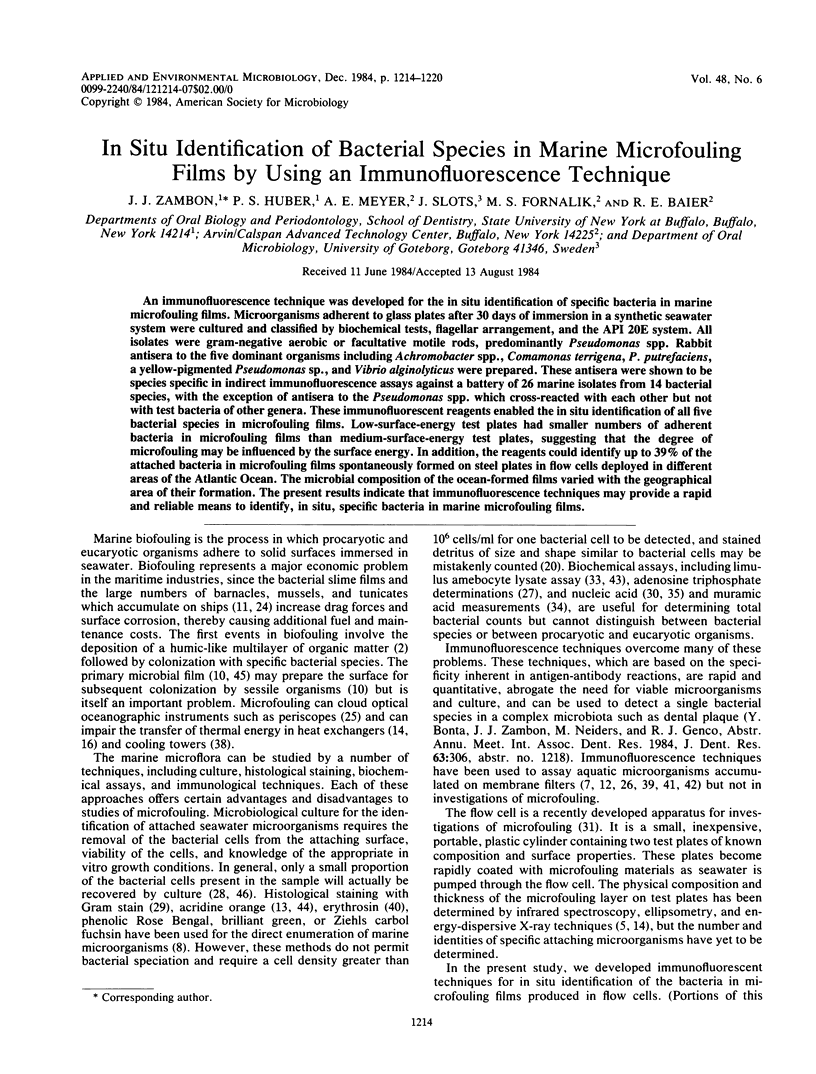
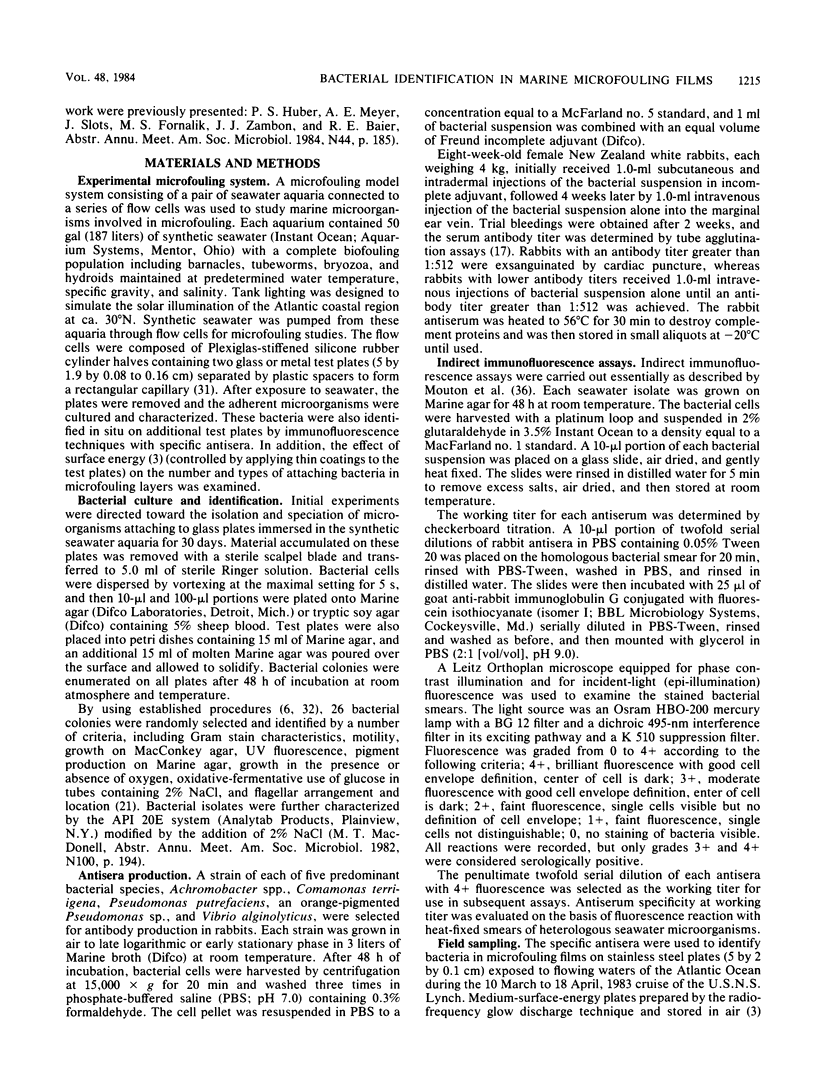
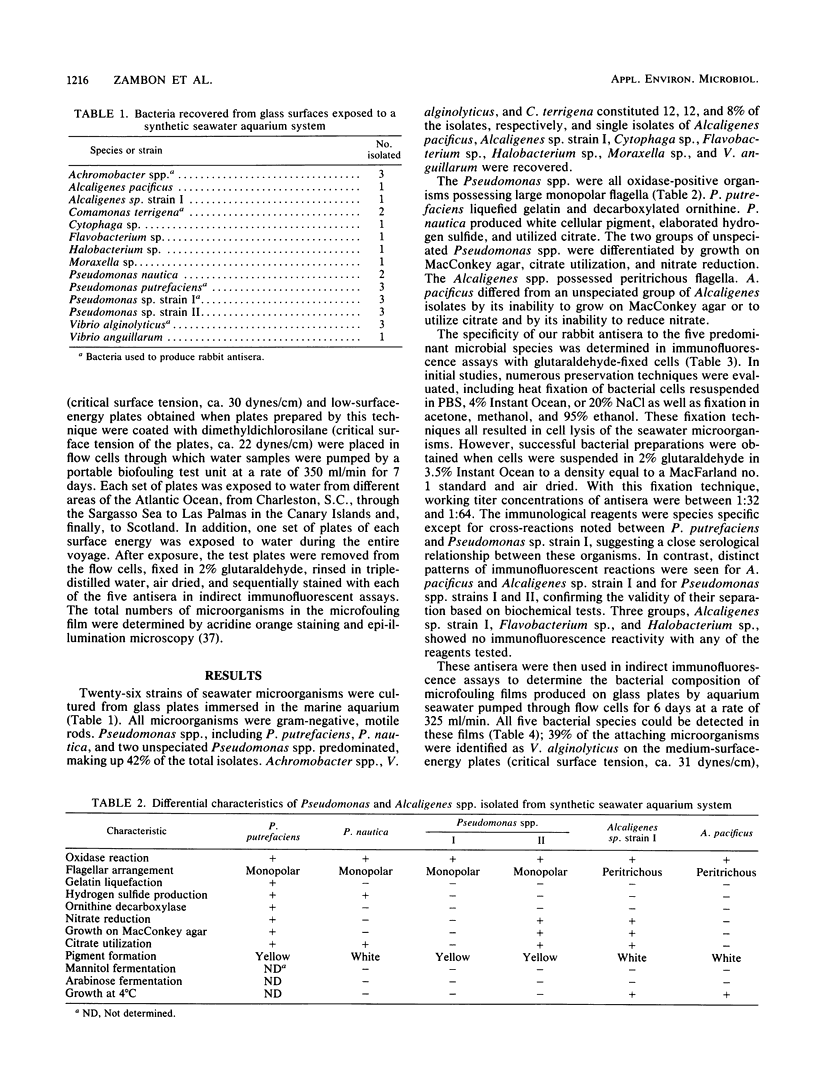
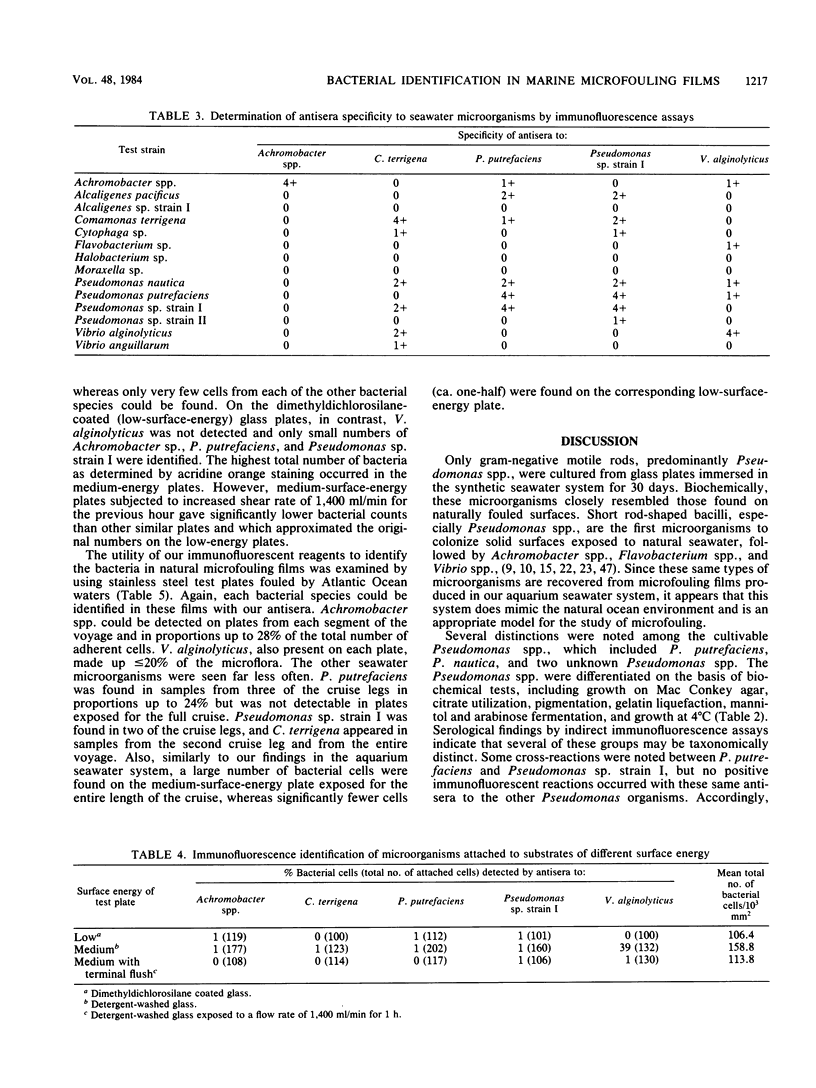

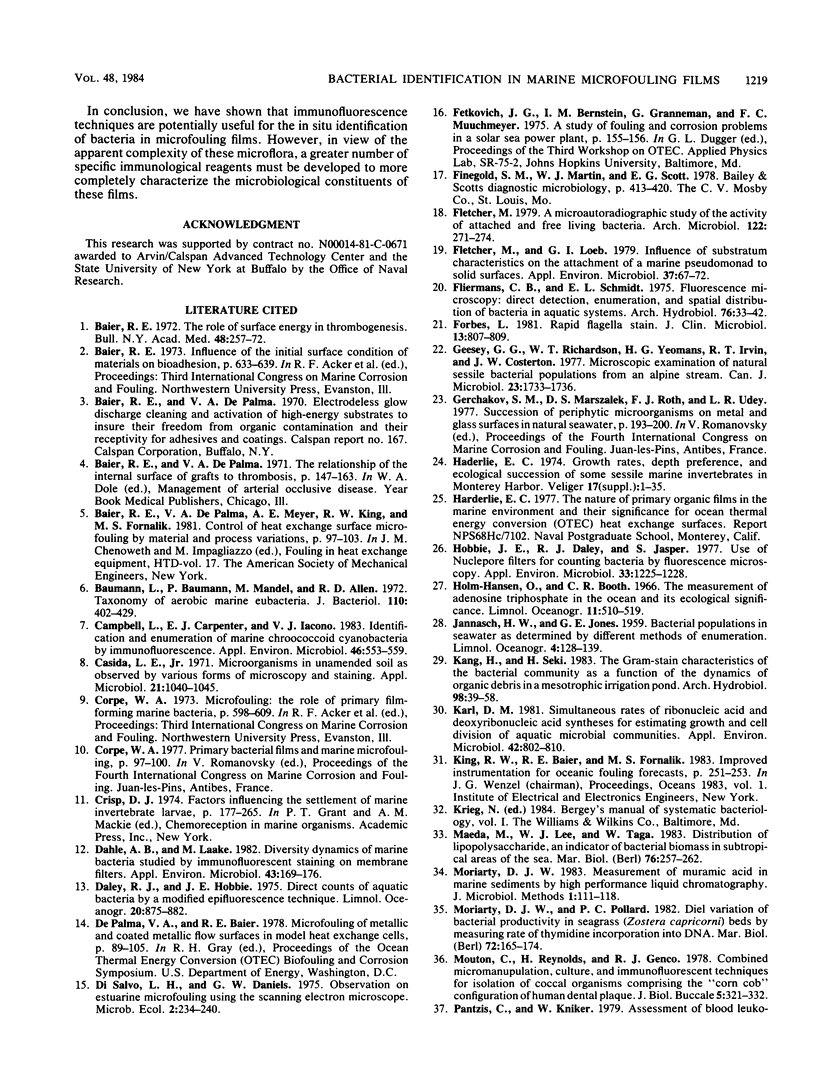
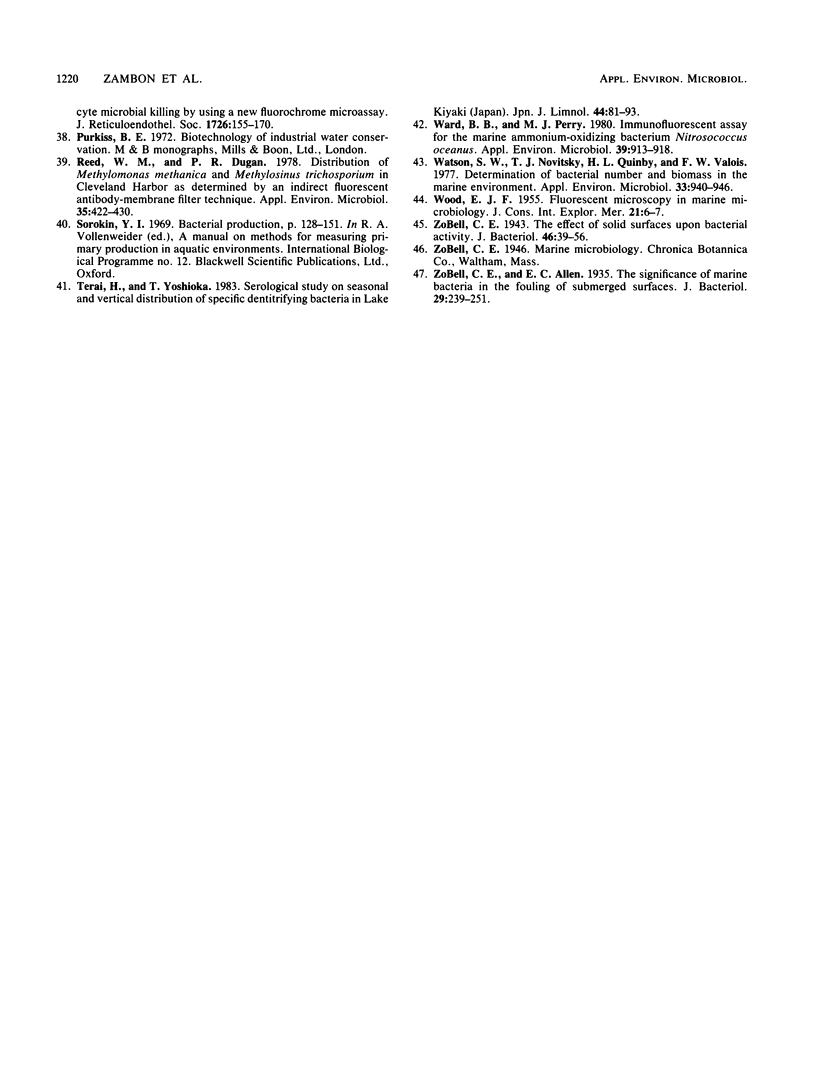
Selected References
These references are in PubMed. This may not be the complete list of references from this article.
- Baier R. E. The role of surface energy in thrombogenesis. Bull N Y Acad Med. 1972 Feb;48(2):257–272. [PMC free article] [PubMed] [Google Scholar]
- Baumann L., Baumann P., Mandel M., Allen R. D. Taxonomy of aerobic marine eubacteria. J Bacteriol. 1972 Apr;110(1):402–429. doi: 10.1128/jb.110.1.402-429.1972. [DOI] [PMC free article] [PubMed] [Google Scholar]
- Campbell L., Carpenter E. J., Iacono V. J. Identification and enumeration of marine chroococcoid cyanobacteria by immunofluorescence. Appl Environ Microbiol. 1983 Sep;46(3):553–559. doi: 10.1128/aem.46.3.553-559.1983. [DOI] [PMC free article] [PubMed] [Google Scholar]
- Casida L. E., Jr Microorganisms in unamended soil as observed by various forms of microscopy and staining. Appl Microbiol. 1971 Jun;21(6):1040–1045. doi: 10.1128/am.21.6.1040-1045.1971. [DOI] [PMC free article] [PubMed] [Google Scholar]
- Dahle A. B., Laake M. Diversity dynamics of marine bacteria studied by immunofluorescent staining on membrane filters. Appl Environ Microbiol. 1982 Jan;43(1):169–176. doi: 10.1128/aem.43.1.169-176.1982. [DOI] [PMC free article] [PubMed] [Google Scholar]
- Fletcher M., Loeb G. I. Influence of substratum characteristics on the attachment of a marine pseudomonad to solid surfaces. Appl Environ Microbiol. 1979 Jan;37(1):67–72. doi: 10.1128/aem.37.1.67-72.1979. [DOI] [PMC free article] [PubMed] [Google Scholar]
- Forbes L. Rapid flagella stain. J Clin Microbiol. 1981 Apr;13(4):807–809. doi: 10.1128/jcm.13.4.807-809.1981. [DOI] [PMC free article] [PubMed] [Google Scholar]
- Geesey G. G., Richardson W. T., Yeomans H. G., Irvin R. T., Costerton J. W. Microscopic examination of natural sessile bacterial populations from an alpine stream. Can J Microbiol. 1977 Dec;23(12):1733–1736. doi: 10.1139/m77-249. [DOI] [PubMed] [Google Scholar]
- Hobbie J. E., Daley R. J., Jasper S. Use of nuclepore filters for counting bacteria by fluorescence microscopy. Appl Environ Microbiol. 1977 May;33(5):1225–1228. doi: 10.1128/aem.33.5.1225-1228.1977. [DOI] [PMC free article] [PubMed] [Google Scholar]
- Karl D. M. Simultaneous rates of ribonucleic Acid and deoxyribonucleic Acid syntheses for estimating growth and cell division of aquatic microbial communities. Appl Environ Microbiol. 1981 Nov;42(5):802–810. doi: 10.1128/aem.42.5.802-810.1981. [DOI] [PMC free article] [PubMed] [Google Scholar]
- Mouton C., Reynolds H., Genco R. J. Combined micromanipulation, culture and immunofluorescent techniques for isolation of the coccal organisms comprising the "corn cob" configuration of human dental plaque. J Biol Buccale. 1977 Dec;5(4):321–332. [PubMed] [Google Scholar]
- Reed W. M., Dugan P. R. Distribution of Methylomonas methanica and Methylosinus trichosporium in Cleveland Harbor as Determined by an Indirect Fluorescent Antibody-Membrane Filter Technique. Appl Environ Microbiol. 1978 Feb;35(2):422–430. doi: 10.1128/aem.35.2.422-430.1978. [DOI] [PMC free article] [PubMed] [Google Scholar]
- Ward B. B., Perry M. J. Immunofluorescent Assay for the Marine Ammonium-Oxidizing Bacterium Nitrosococcus oceanus. Appl Environ Microbiol. 1980 Apr;39(4):913–918. doi: 10.1128/aem.39.4.913-918.1980. [DOI] [PMC free article] [PubMed] [Google Scholar]
- Watson S. W., Novitsky T. J., Quinby H. L., Valois F. W. Determination of bacterial number and biomass in the marine environment. Appl Environ Microbiol. 1977 Apr;33(4):940–946. doi: 10.1128/aem.33.4.940-946.1977. [DOI] [PMC free article] [PubMed] [Google Scholar]
- Zobell C. E., Allen E. C. The Significance of Marine Bacteria in the Fouling of Submerged Surfaces. J Bacteriol. 1935 Mar;29(3):239–251. doi: 10.1128/jb.29.3.239-251.1935. [DOI] [PMC free article] [PubMed] [Google Scholar]
- Zobell C. E. The Effect of Solid Surfaces upon Bacterial Activity. J Bacteriol. 1943 Jul;46(1):39–56. doi: 10.1128/jb.46.1.39-56.1943. [DOI] [PMC free article] [PubMed] [Google Scholar]


